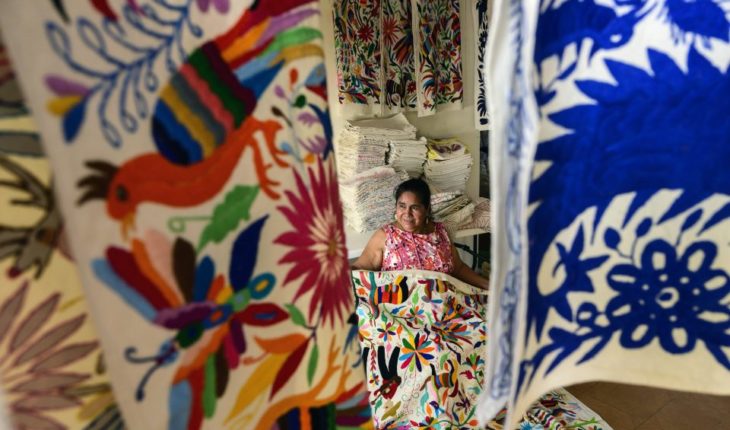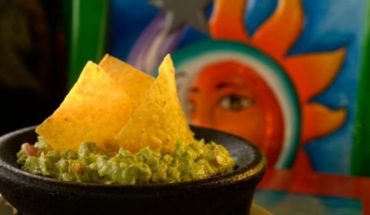Surrounded by piles of red, blue and yellow embroidered blankets, Glafira Candelaria, a 59-year-old Mexican native who speaks Spanish with difficulty, is outraged at the latest collection of the carolina Herrera fashion house, which used textile designs from her village.
“He’s just copying our work, what we’re doing, but that’s not enough,” he says at home.
It lives in San Nicolás, village of the municipality of Tenango de Doria, in Hidalgo, nestled in an area of mountains inhabited mostly by Indigenous Otomí.
Read: Why they criticize Carolina Herrera’s collection making a cultural appropriation of Mexico
Carolina Herrera’s creative director, American Wes Gordon, used birds and roosters surrounded by trees and loose leaves that characterize the laborious Tenango embroidery technique and designs of two other Mexican communities in his latest collection, called Resort 2020.
The collection provoked the mexican government’s protest, which asked Carolina Herrera – a New York fashion house founded in 1980 by the iconic Venezuelan designer of the same name – an explanation of what she saw as an “appropriation” of iconography Native.
The collection “pays homage to the richness of Mexican culture” and recognizes “the wonderful and diverse craftsmanship” of the country, argued Gordon, who took the creative reins of the company a year ago from Herrera, who is 80 years old.
“They get rich with our work”
But Glafira and her neighbors don’t accept that explanation.
“People who come from outside just get rich with our work, with what we’re doing because they sell it well expensive (…). These people can also sue or apologize,” adds Glafira, whose face is overshadowed by seeing photographs of the dresses in the Resort 2020 collection, which sell for thousands of dollars.
The International Charter of Human Rights recognizes intellectual property as part of the fundamental rights of man, and Mexico’s federal copyright law states that all works deemed to be popular art or Craft.
The law also mandates to recognize with a clear and direct mention the indigenous community from which these works come, if they are used to create new products.
While “there is no appropriation of the designs,” the case could warrant “a trade violation for omitting the mention of the ethnic community and the Mexican government is demanding it,” said the copyright attorney, Daphne Méndez.
You may be interested: Chiapas artisans organize to combat plagiarism in their tissues
Glafira’s mother, Josefina José Tavera, 87, lives in the back of her house, in a small room with her own entrance and dirt floor where the only electrical apparatus is the spotlight that hangs from the ceiling.
She is recognized in the village as the creator, together with her mother, of Tenango textile technique and design.
Tavera no longer hears and her eyesight is getting worse every day. He has been underembroidering for a long time, so he is dedicated to collecting leaves for temazcal (steam bath for medicinal purposes), which he finds in El Cirio, a set of mountains of whimsical forms from which he returns walking slowly carrying a large lump that hangs from his head.
“If it wasn’t for my hands there wouldn’t be this craft!” she says annoys her house, where she accumulates cartons of eggs she uses as chairs.
Josefina wears a blouse with a delicate and tiny embroidery of animals. The old lady and her deceased mother were inspired by these images to create the embroidery that identifies their community.
The craftsmen spend about five hours a day knitting a table path in six months, and up to a year and a half to make a six-metre tablecloth, selling for about $65 and $250 respectively.
“Bring us work”
The use of indigenous community designs on international catwalks is not new.
Zara, Mango, Isabel Marant and Rhapsody are other brands that have been noted to “appropriate” the designs of the indigenous peoples of Mexico.
“What you have to do is have them come directly with us. First, let the craftsman be recognized so that other people know where it comes from. Bring us work,” he says in his workshop, which is also his home, Oliver López, a 29-year-old Otomí, who like Carolina Herrera has also created minidresses with Tenango embroidery designs and other garments, but without the success of the New York fashion house.
Two other pieces from the Resort 2020 collection include embroidery from the isthmus of Tehuantepec, which identify women from that region of southern Mexico, and two other models incorporate the “sarape Saltillo”, a kind of wool or multicolored cotton blanket, similar to the poncho , and used as a coat.
Is the culture everyone’s?
Where do designers get their ideas? Is the culture everyone’s? Did Mexico get it right to accuse Carolina Herrera of cultural appropriation for resuming patterns from indigenous communities? Kim Jones (Dior), Kris Van Assche (Berluti) and Alejandro Palomo (Palomo Spain) have their say (and diverge with each other).
These designers, who presented their respective collections at Men’s Fashion Week agree that their job is to take inspiration from what surrounds them.
But the perception is not the same between Alejandro Palomo, an ascending creator who founded his own brand four years ago in southern Spain, and Van Assche and Jones, who work for luxury firms with decades of tradition and whose goal is to perpetuate their line and style.
The Mexican government’s criticism of the latest collection by the US firm Carolina Herrera, which used textile designs from three indigenous communities, in any case reopens the debate about the extent to which firms should be held accountable when they are inspired by the traditional know-how of minority groups.
Peoples and communities of Mexico will be the holders of the right to the use and use of its cultural elements.
They enlist the first law initiative to protect the creativity of artisans and stop the plagiarism of popular art.
We tell you ?? https://t.co/VrNYKuD0Ca pic.twitter.com/XK9MpsggpI
— Secretariat culture (@cultura_mx) June 12, 2019
“Cultural appropriation is something we should forget about. Today there is too much controversy,” says Alejandro Palomo, 27. “They also told Rosalía” about Flemish culture. “I think it’s very nice to interpret culture: we live in a global world and we all belong to it.”
“Carolina Herrera more than hurt, brings us a little closer to Mexican culture”, insists the Spanish designer of menswear, although her most reputable clients are women, like the Catalan singer, as well as Madonna and Beyoncé.
“It’s like I used a flyer and they call it cultural appropriation. Well, no,” adds this Cordoba whose signature is in his village of Posadas.
Berluti’s new artistic director, Belgian Kris Van Assche, admits that being inspired by other cultures is learned from fashion school.
“I studied at the Antwerp Academy,” one of the most reputed in the world. “There we learn to inspire ourselves from cultures, there is nothing dishonest about it.” “The important thing is to recognize it and reinterpret it,” said the 43-year-old designer.
“The question is whether there is abuse or not” and in Carolina Herrera’s case “I don’t know it,” admits the designer at the helm of Berluti, founded in 1895.
Van Assche, former artistic director of Dior’s men’s line for more than a decade, estimates that his history of historic houses has helped to avoid such problems.
“Personally I’m inspired by the house and nobody blames me,” he concludes.
Cultural appropriation or appreciation?
“There are two currents of thought: is it about appreciation or cultural appropriation?”, mends the British Kim Jones, at the head of Dior man’s artistic direction.
“When I worked with things that have a culture that had a culture or asked permission from the people who worked with it and got a royalty or worked with them, so we were helping them, that’s essential.”
Jones, 39, argues to know what he’s talking about from his previous experience at Louis Vuitton, a traditionally luxury travel brand.
“With Dior, dive into your archives. With Vuitton we were interested in the stories behind the trunks and their travels.”
“I think you have to develop a lot of sensitivity” in the fashion world and “treat everyone with a lot of respect,” he says.
Thanks for reading! Help us get on with our work. How? You can now subscribe to Political Animal on Facebook. With your monthly donation you will receive special content. Find out how to subscribe here. Check out our list of frequently asked questions here.





